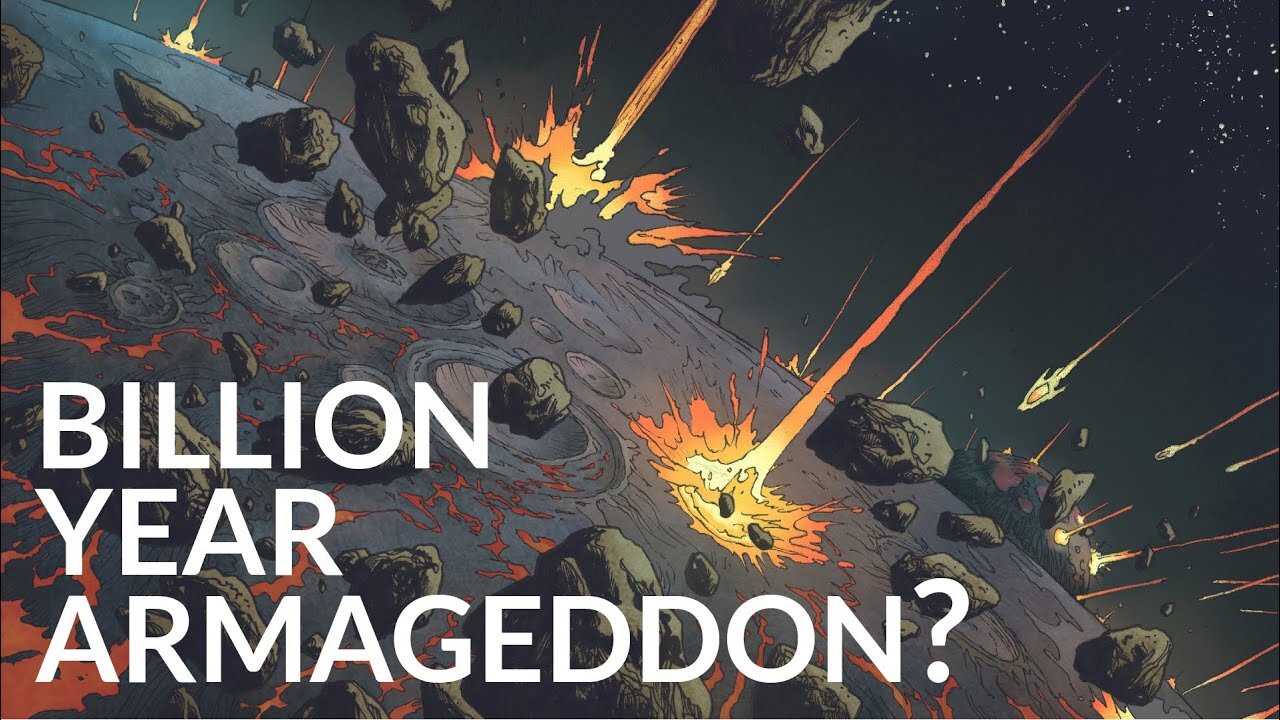Premium Only Content

The Mystery of the Late Heavy Bombardment
Researched and Written by William Painter
Revised by Pete & David Kelly
Narrated and Edited by David Kelly
Art Provided by Khail Kupsky
Thumbnail by Ettore Mazza
[1] A collection of radioactive chronometers were employed to reach this date. Most notably these include pairings of U-Pb, Rb-Sr, Sm-Nd, and Ar40-Ar39, each of these including a parent atom and a decay product.
[2] Jupiter’s gargantuan mass can inflict chaos on the orbits of smaller bodies over millions and billions of rotations. The danger becomes acute if the orbit of the junior body reflects a ratio of Jupiter’s orbit (for example if the body orbits twice for every single orbit of Jupiter.) In this case the body will pass Jupiter at the same time and place in each orbit and Jupiter’s gravity will pull strongest on the body at the same time and place in each orbit. Over many orbits the slight tug will incrementally draw the junior body out of a circular path and into ever more eccentric ellipses. Eventually this oblong orbit will intersect the orbits of the terrestrial planets.
[3] This phenomenon is called decompression or adiabatic melting is a key feature of plate tectonics on Earth today.
[4] The age of Borealis Basin is somewhat controversial. Without direct access to the physical crater we rely on the fragments of Mars that fall to Earth as meteorites. The oldest known igneous Martian meteorite ALH84001 was forged through the accumulation of crystals floating in a body of magma. It’s therefore postulated that ALH84001 was created during or after the Borealis impact as this event melted half of Mars and deeply buried the other half, erasing any trace of prior martian history.
[5] Around 40% of all meteorites found are classified as H chondrites and most likely originate ultimately from the asteroid 6 Hebe. Around 35% are L chondrites and likely originate from either 433 Eros or 8 Flora. Mesosiderites from 16 Psyche and eucrites from 4 Vesta round off the list of four parent asteroids upon which we find evidence of impacts between 3.5 GA and 4.1 GA. It’s a short list.
[6] Obsessive investigations into the most resilient minerals on the planet, Hadean zircons, unveil a slight bump in temperature between 3.8 and 4.0 billion years ago--the lingering trauma of an otherworldly pummeling? But in all the world only 4 miniscule mineral grains record the bump.
[7] Noting our inability to acquire physical evidence from other planets scientists sought a different way to date geologic features. Since surface imagery was comparatively abundant a sophisticated statistical method was developed to assess age by counting the size and frequency of craters present on a terrain and comparing this size frequency distribution (SFD) to that of a known terrain. This process is fairly effective at achieving relative ages, but caught criticism for some assumptions it makes.
[8] At first glance it appears impossible that the Apollo 16 and 17 sample should come from the Imbrium impact, in each case over a thousand kilometers away. Improved imagery acquired decades later however reveals a radial pattern of debris emanating from Imbrium Basin that overprints both landing sites.
[9] Imbrium is the youngest basin on the near-side of the Moon; much of the volcanism on Mercury ceased by that time; the major basins of Mars all betray the ephemeral presence of liquid water before it vanished from the planet. Echos of this early era still reverberate through the Solar System; solitary giants can wreak havoc especially on our fragile ecosystems, but the terrible scale of the calamity has never again been matched.
[10] In the interest of full disclosure, a continuous (monotonic) bombardment is the perspective that makes the most sense to me. Not only because the physical evidence is sparse and is getting sparser but because the erasure of terrestrial history is a throughline of geology. The destructive power of geologic processes has been on display throughout this narrative and it is a very sensible explanation for the negative anomaly we find in the impact history (a negative anomaly which is now significantly shorter than the “spike” of the LHB.) Furthermore models have consistently shown that while orbital evolution among the gas giants should be expected early on, it’s exceptionally rare for this dynamism to last more than a few 100 MA and virtually impossible for the orbits to calm for several 100 MA then return to a dynamic state. In the absence of a convincing causal mechanism I personally conclude that the LHB is fictitious. (William Painter)
Thanks to:
Mitch Ames - Moon Rock
the Illinois State Museum - Moon Rock Mangolava Imbrium Crater
By Brocken Inaglory, CC BY-SA 3.0, https://commons.wikimedia.org/w/index... with landing numbers)
NASA/JPL-Caltech
Epidemic Sound for the music
-
 LIVE
LIVE
suntsunami
3 hours agoBRAVE WORLD OR A NEW HEART | LowTierGod Restream Live 🔴
2,331 watching -
![[LIVE] Bully | GTA: Vice City | First Playthrough | 8 | Rampage and The Spirit of The Season](https://1a-1791.com/video/fwe1/85/s8/1/W/e/n/4/Wen4x.0kob-small-LIVE-Bully-GTA-Vice-City-Fi.jpg) 3:15:35
3:15:35
Joke65
5 hours ago[LIVE] Bully | GTA: Vice City | First Playthrough | 8 | Rampage and The Spirit of The Season
22.1K -
 3:27:04
3:27:04
Laura Loomer
7 hours agoEP103: Dems Promote Violent Anti-Trump Protests Nationwide
32.8K8 -
 LIVE
LIVE
Fairy Mysterious Adventures
5 hours agoStardew with the Rumble crew #16
1,351 watching -
 1:28:42
1:28:42
Kim Iversen
9 hours agoThe War on Terror Was a Scam? Is Osama Bin Laden Really Dead? SEAL Who Killed Him Breaks It Down.
54.6K96 -
 1:09:44
1:09:44
Slightly Offensive
7 hours ago $8.01 earnedALMOST SERIOUS: How Mass Legal Immigration DESTROYED Australia | Guest: Maria Zeee
54.7K15 -
 2:38:38
2:38:38
TimcastIRL
6 hours agoTrump Orders DOJ To FIRE EVERY Biden Attorney, Calls For CLEAN HOUSE w/Siaka Massaquoi | Timcast IRL
130K79 -
 1:29:31
1:29:31
Glenn Greenwald
10 hours agoGermany's Repressive Speech Crackdown Intensifies; U.S. & Russia Meet in Saudi Arabia and Open Cooperation; Plus: An Amazing Hate Crime in Florida is Buried | SYSTEM UPDATE #408
95.8K57 -

DLDAfterDark
4 hours ago $1.32 earnedDLD Live! What's Your Typical EDC/Civilian Load Out? Guns & Ammo & EDC?
17.8K1 -
 1:30:48
1:30:48
Redacted News
11 hours agoBREAKING! TRUMP AND PUTIN NEARING PEACE BUT EUROPEAN WARMONGERS TRYING TO STOP IT | REDACTED
190K249